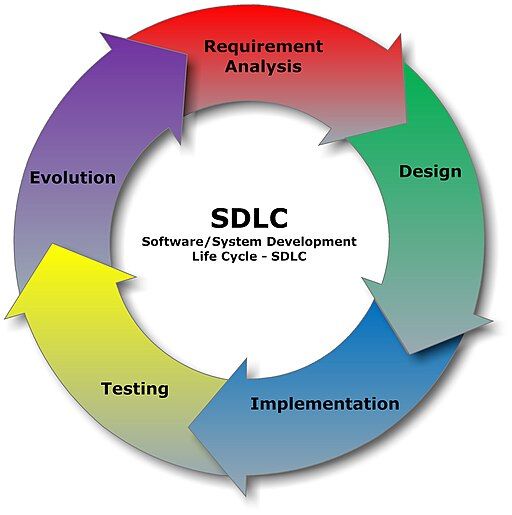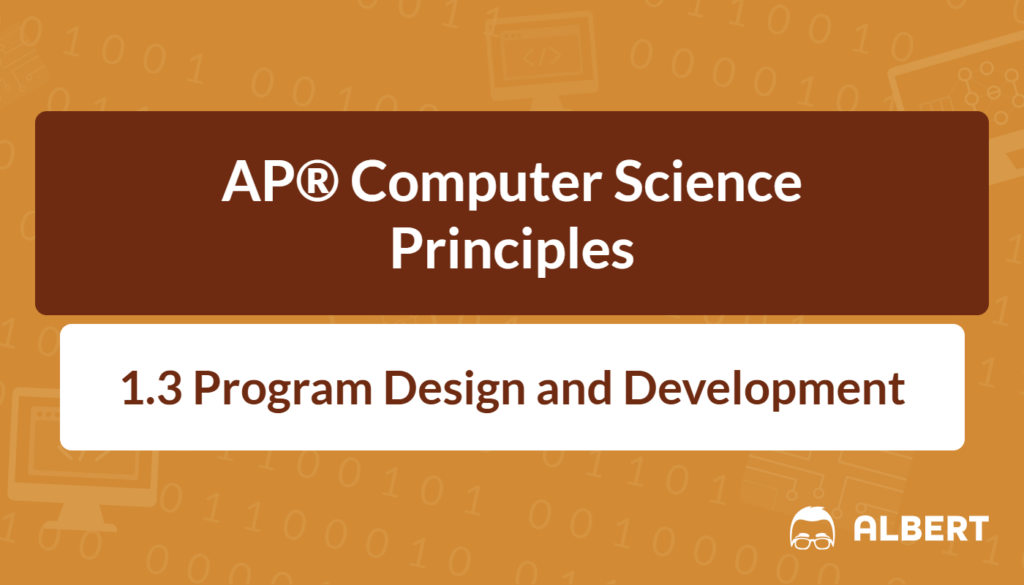Program design and development are at the heart of every successful software project. Therefore, it is vital to understand how to plan, build, and improve a program in an organized way. This ensures that the final result meets the needs of its users while remaining efficient and reliable. High school students taking AP® Computer Science Principles benefit greatly from learning about the development process early on. As a result, they can gain confidence in creating programs step by step and refining their work as new ideas emerge. Mastering this cycle of design and development also helps future programmers communicate more effectively and collaborate on projects. Next, this post explores the phases of program development, as well as best practices like clear documentation and crediting external code.
What We Review
The Development Process
The development process is a structured method for turning ideas into functioning software. Sometimes it follows an ordered path, with each phase happening in a specific sequence. However, other times it is more exploratory, where programmers experiment and adapt as they learn. Both approaches are valid, and the choice depends on the complexity of the project and the preferences of the development team.
- Ordered approach: Plan each step in advance and follow the plan closely.
- Exploratory approach: Make small changes, gather feedback, and adjust rapidly.
In either case, the main goal remains the same: build a program that satisfies both user and system requirements.

Phases of Program Development
Investigating and Reflecting
In this phase, programmers discover what problem a program should solve. Therefore, it involves learning about user needs, possible constraints, and the goals of the project. By understanding why a program is needed, the specification can clearly outline what features and interactions to include.
- Example: Conduct a short survey asking students about the biggest challenges in their daily schedule. From their responses, define the key functions a scheduling app should offer (e.g., reminders, notifications).
Designing
After gathering requirements, the next step is to plan how the program will function. Brainstorming, storyboarding, and creating diagrams help outline each feature. As a result, this keeps the workflow organized and ensures that the program meets all requirements.
- Example: Draw a simple blueprint for a calculator that shows buttons for numbers and operations. Decide how the program will handle user input, and then consider possible edge cases like dividing by zero.
Prototyping
A prototype is an initial version of the program. During this step, programmers build a small sample to test main features or get early feedback. However, this version is not the final product—it is part of the design and development process.
- Example: Develop a basic prototype of the calculator that accepts two numbers and an operation. Make it display the results in a simple interface. Gather feedback from classmates on whether it is easy to use.
Testing
Testing helps ensure that the program functions correctly under different conditions. In addition, it catches errors before release. Unit testing checks small parts of the program individually, while integration testing checks if these parts work well together. User acceptance testing checks the program directly with potential end-users.
- Example: Test the calculator by trying different operations: addition, subtraction, multiplication, and division. Check if it correctly handles unusual inputs, like very large numbers or negative values.
The Iterative and Incremental Development Process
An iterative and incremental process of program development breaks the project into smaller pieces that can each be tested and improved. First, create a basic version of the application. Next, gather feedback from users or teammates. Then, revise the existing features and add new ones. Iteration often means revisiting earlier stages of design and development (investigating, designing, or testing) multiple times.
- Example: Build a first version of a to-do list program that only allows adding daily tasks. After using it for a week, notice that tasks need deadlines. Therefore, return to the design phase, add a deadline feature, and test this new feature thoroughly before moving on again.
Designing Programs and User Interfaces
Effective program design focuses on meeting user needs and making the interface easy to learn and navigate. Therefore, it is important to investigate these needs before coding. This can be done by:
- Conducting surveys that ask about user habits and preferences
- Running user tests on early versions of the program
- Holding interviews to gain deeper insights
- Observing how people currently solve the problem
For instance, if designing a reading app, observing how people select books in a library can inspire intuitive features. By paying attention to real user behavior, programmers can adjust the user interface to be more friendly and efficient.
- Example: Use direct observation by watching how classmates take notes in class. Then, design a digital note-taking program with easy formatting tools and search options, reflecting the steps students naturally take on paper.
Writing Documentation in Programming
What is documentation in programming? It is a written explanation of how a code segment, event, procedure, or entire program works and why it was developed in a certain way. Programmers should document a program throughout its development, because notes made early can prevent confusion later.
Comments are a common form of program documentation. They are written directly into the code and do not affect how the program runs. For instance, writing // This variable stores the user’s preferred language helps future readers understand the logic faster.
- Example: Below is a simple snippet for printing a welcome message:
DISPLAY("Welcome, user!") // Displays a greeting messageSuch comments make it easier for both current and future developers to maintain and update the program.
Acknowledging External Code Segments
Sometimes, programmers use code from others to solve specific problems more efficiently. In this case, it is important to credit the original source. Failing to do so can be considered plagiarism. Therefore, acknowledging external code helps maintain academic integrity and fosters a culture of sharing.
- Example: Document a borrowed sorting algorithm with a note at the top of the file:
// Sorting function adapted from John Doe’s online article (www.example.com) posted on 01/01/2022This ensures that future collaborators know where the code came from and can find additional details if needed.
Quick Reference Vocabulary Chart
Below is a concise list of key terms related to design and development.
- Algorithm – A step-by-step procedure to solve a problem
- Program Development Process – An ordered or exploratory method used to plan, create, and refine software
- Investigating and Reflecting – The phase of understanding user needs, constraints, and success criteria
- Designing – Outlining specifications, plans, and design diagrams for an upcoming program
- Prototyping – Building a basic version of a program for initial feedback
- Testing – Checking the program’s correctness through various forms of testing
- Iterative Development – Cycling back through phases based on feedback or new insights
- Incremental Development – Creating small, working sections of code and adding them together step by step
- Program Documentation – Written descriptions of what the code does, how it works, and why decisions were made
- Comments – In-code notes that do not affect program execution
- Acknowledgment – Crediting any code or ideas taken from external sources
Conclusion: Program Design and Development
Design and development are essential skills for aspiring programmers and problem solvers. By following a structured process, students can create programs that satisfy user needs while embracing the flexibility to explore new ideas. Iterative and incremental processes encourage routinely gathering feedback, then refining and expanding features. Meanwhile, writing clear documentation and properly crediting sources ensures that programs remain transparent and easier to maintain. Ultimately, the most successful projects balance creative thinking with solid planning. Such balanced program development leads to practical and long-lasting solutions, preparing high school learners for further studies and a future in technology.
Sharpen Your Skills for AP® Computer Science Principles
Are you preparing for the AP® Computer Science Principles test? We’ve got you covered! Try our review articles designed to help you confidently tackle real-world AP® Computer Science Principles questions. You’ll find everything you need to succeed, from quick tips to detailed strategies. Start exploring now!
Need help preparing for your AP® Computer Science Principles exam?
Albert has hundreds of AP® Computer Science Principles practice questions and full-length practice tests to try out.








